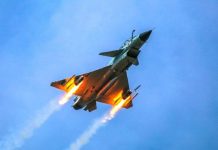French Navy has received the first of six Suffren-class nuclear attack submarines (SSN) from Naval Group as a replacement for the Cold War-era Rubis-class submarines. The handover ceremony took place on 6 November in Toulon, where Minister of Defense Florence Parley was also present.
SNEAK PEEK: Did China Accidentally Reveal Its New Anti Radiation Missile On Board J-11BS Flanker?
The submarine with tail number S 635 will be inducted into the French Navy in 2021. Till then the submarine will undergo operational tests under the ministry of defense.
The 99m long submarine, built under the $10.13bn Barracuda stealth vessel program will serve as the French submarine forces’ backbone until the 2060s.
[Video] ?️Another exclusive interview about the #Suffren / Barracuda type #SSN by @navalgroup for the @MarineNationale . This time we take you inside the (virtual) Combat Information Center #CIC or Smart Ops Room ⚓️?? Full length video at this link ?▶️https://t.co/veqHrNScs6 pic.twitter.com/escodIxZIj
— Naval News (@navalnewscom) July 23, 2019
Five of the six submarines will be delivered within the next ten years. Each submarine, equipped with F21 heavyweight wire-guided torpedoes and modernized Exocet SM39 anti-ship missiles, can accommodate a crew of 65 people plus special forces.
The submarine will take the French Navy from the Cold War era to the 21st century. The Suffren-class is meant for special operations insertions, land and surface attack, convoy escort, and submarine hunting.
Part of the $10.13bn Barracuda stealth vessel program, the first Barracuda-class nuclear-powered attack submarine was laid down in December 2007, launched in July 2019, and factory sea trials began on April 27, 2020.
It is equipped to fire the Storm Shadow, an Anglo-French built and designed cruise missile which has some low-observation features, making it hard to detect.
The missile’s specialized French variant, called SCALP EG, has a range of about 1,000 kilometers, or just under 625 miles, and can be fired by the Suffren-class. At this range, it could strike targets hundreds of miles out to sea, or lie in wait near enemy shores and hit targets far inland.
Caleb Larson describes in The National Interest that the submarine has the most interesting piece of technology in optronic mast – a sensor that includes a high-definition camera as well as a laser rangefinder, replacing the traditional periscope mast that submarines are typically fitted with.
“The design is a boon to the submarine’s structural integrity, as a large hole to accommodate a periscope does not need to be drilled through the hull,” says Larson.
Even though at 5,000 ton, the Suffren class is smaller than attack submarines of the Royal Navy’s Astute-class (around 7,500 tons), and American Virginia-class and Seawolf-class (over 8,000 tons each), it benefits from being nuclear-powered.
As per Larson, once complete, the class may be one of the most advanced nuclear attack submarines in Europe.
Recently, the French shipbuilder Naval Group had offered to make P75I class submarines for the Indian Navy. As per the P75I submarines tender discussed between the French Defense Minister Florence Parly and her Indian counterpart Rajnath Singh in September, the six stealth submarines will be built with air-independent propulsion technology that would have a longer submerged range than subs already possessed by the Indian Navy.
Considering the advanced technology with the Naval Group, the transfer of technology by the French manufacturer will benefit India’s indigenous submarine program. France has shown military and political support to India with the timely delivery of Dassault Rafale jets, in spite of the pandemic.
Amid the growing defense cooperation between the countries with the delivery of fighter jets and talks of submarines, it would be a good opportunity for India to acquire more advanced technology amid China’s rising influence in the Indian Ocean Region.




